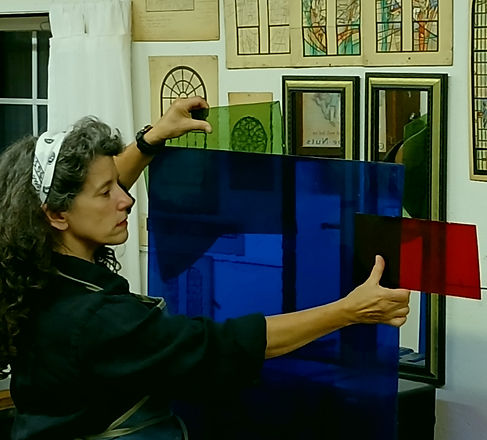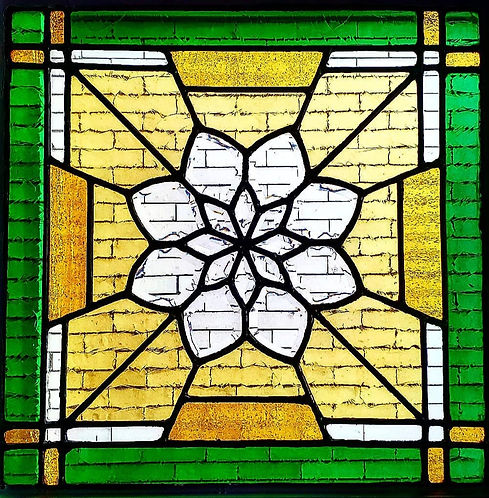The Full Story
History
Discover the history of classically trained stained glass artist, Regina Carmine who specializes in traditional techniques. With years of experience, she now creates historically accurate pieces that capture the beauty of medieval craftsmanship.

The Artist
Regina Carmine is a classically trained stained glass artist. After receiving her bachelor's degree in History from Washington & Jefferson College, she apprenticed under a master of the craft, Leonid Linauts. Linauts studied his art prior to World War II in the European medieval tradition. He taught Regina in this same fashion. As such she is part of a small handful of people who understand this craft both historically and technically. Regina served an apprenticeship in the European tradition, becoming a master designer, glass cutter, and glazier. After climbing scaffolding and working with Linauts until his retirement, she opened her own studio in 1990 in Berks County Pennsylvania. Her commission based work was soon filling churches,board rooms and private collections.
Regina has numerous works in sheet glass and lead as well as the dalle de verre process using slab glass and epoxy. Years of commission work and a great creativity bloomed into fusing glass for gallery work that encompassed bowls, plates, sculptural pieces and vases. She taught at Touchstone Center for crafts over the course of a decade. Classes ranged from teaching the basics of creating in leaded glass, painting on glass, fusing basics, etching and slab creations. She is a lecturer on the subject of traditional stained glass and has spoken in numerous churches. During these speaking engagements, Regina explains the process of creating the windows as well as explains the symbolism and technical information that brings the windows to new light for the parishioners who look up at them during services.
Her recent work combines her love for history and her love for glass. Regina has been making historically accurate reproductions of medieval glass. She “zooms in” on “fragments” of large rose windows and reproduces (using medieval techniques) pieces that can bring this ancient beauty into modern homes.
The Art
What is Stained Glass?
"For with thee is the fountain of life: in thy light shall we see light." Psalm 36:10
The great church windows by master glaziers, like the windows of York Minster, Saint Denys or Chartre are of course extraordinarily beautiful, but that was not their purpose. Stained glass windows of cathedrals and churches were created by masters to disorient the worshiper. The colored lights of church glass obscures the profane world outside the church and brings us into the sacred world of the divine, and finally transports us to the immaterial realm of the angels.
Enter the cathedral nine centuries ago: there is no electricity, no light other than candles and the streams of corpuscular light shining through the colored windows above and around -- rays of light shining through the smoke of candles and incense. This was the light of angels dancing in the vaulting of the ceiling and descending down to the worshipers in the pews. In the church, through the stained glass lenses, the light of the angels touched them, illuminated them and communicated with them.
"Angels amassing...sublime creatures beneath the throne,
charged carriers encased in light." Ibn Gabirol
The dusty beams of light shining through stained glass windows of master glaziers began a process of spiritual purification, illumination and ultimately perfection. In those lights, rays, shining down from clearstory lenses, rose windows and walls of narrow lancets the medieval worshiper climbed Jacob's ladder, up to the ineffable divine. The angel light took them up spiritually through the fragile glass itself, up and out of the material church building and into the immaterial celestial domain of the angels themselves who alone are able to look directly at the blazing light of God and communicate God’s messages back down to us.
The intent of the medieval glaziers was to make windows whose light would make us feel what Moses felt on Mount Sinai or Jesus at the moment of his blazing transfiguration. The stained glass lights were designed by architects, stonemasons, glaziers and iron workers to create the dancing rays of the light of angels in the rafters and ceiling beams, shining down the columns and down onto the floor of the nave.
The light of the stained glass illuminated the worshiper, who was momentarily frozen by the divine light, lux sancta, of God.
Even now, with our phones and cameras, tourists in an ancient church, we still may feel a bit of the shudder the ancients felt when we look up at a rose window with rays of light shining down, like holy muted rays shining through the leaves of trees onto a shadowed forest floor of benches and mosaics in the nave. Komorebi in the Cathedral forest.

.png)